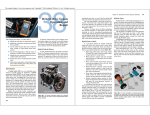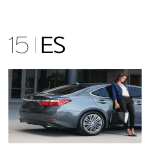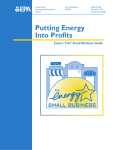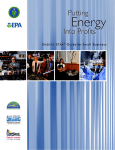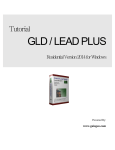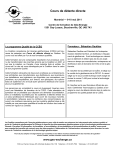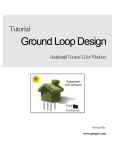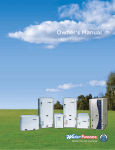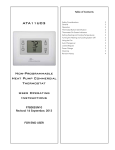Download WaterFurnace Premier2 Owner`s manual
Transcript
Owner's Manual Residential Products You now own some of the world’s most advanced and valued technologies. Congratulations on your WaterFurnace purchase! Register Your Warranty In order to receive full warranty benefits, it is necessary to register your unit. Registration is quick and simple with our online form. Register your unit today! Note: We respect your privacy. Please be assured that we will not provide your personal information to any outside company. Visit: warranty.waterfurnace.com My Warranty Date registered: ITEM/DESCRIPTION Overall Warranty: TERMS Parts Warranty: ________ Compressor Warranty: ________ ____________ Labor Allowance on warranted parts: Labor Allowance on compressor: Workmanship/dealer supplied materials: ________ ____________ ________ ACCESSORIES __________________ __________________ __________________ __________________ __________________ _________ _________ _________ _________ _________ For a quick reference, write your WaterFurnace dealer's important information below: Company Name: ______________________________________ Telephone Number:_ _______________________________ Date of Installation:____________________________________ Type of Warranty:__________________________________ Unit Model Number:___________________________________ Serial Number:_ ___________________________________ Type of Loop System (Refer to the loop section of this manual for assistance.) o Horizontal Closed Loop o Vertical Closed Loop o Pond Loop o Open Loop/Well Water Type_ _________________ # boreholes____________ # coils_________________ Gallons per minute_______ # trenches/bores________ Depth of boreholes_ _____ Ft. of pipe______________ Discharged to___________ Trench length___________ Pond depth_____________ Depth_ ________________ Loop Antifreeze: (Type)________________________________________________________________________________ Major Options Installed (check all that apply): o Auxiliary Heat: Internal_ ____________________ External____________________ kW_ __________________________ o Hot Water Assist o Electronic Air Cleaner (brand):_ _______________________________________________________________________ o Electrostatic Air Filter (brand): ________________________________________________________________________ o Auxiliary Heat: (brand)_ _______________________________________________ #zones________________________ o Humidifier (brand): __________________________________________________________________________________ o Other:_ ____________________________________________________________________________________________ Table of Contents GEOTHERMAL SYSTEM TECHNOLOGY & BENEFITS . . . . . . . . . . . . . . . . . . . . . . . . . . . . . . . . . . . . 6 ABOUT YOUR WATERFURNACE SYSTEM . . . . . . . . . . . . . . . . . . . . . . . . . . . . . . . . . . . . . . . . . . 7-18 How Geothermal Systems Work . . . . . . . . . . . . . . . . . . . . . . . . . . . . . . . . . . . . . . . . . . . . . . 8-11 Typical Installation & Components . . . . . . . . . . . . . . . . . . . . . . . . . . . . . . . . . . . . . . . . . . . 12-13 Closed Loop Systems . . . . . . . . . . . . . . . . . . . . . . . . . . . . . . . . . . . . . . . . . . . . . . . . . . . . . . . . . 14 Open Loop Systems . . . . . . . . . . . . . . . . . . . . . . . . . . . . . . . . . . . . . . . . . . . . . . . . . . . . . . . . . . . 15 Your Loop Location . . . . . . . . . . . . . . . . . . . . . . . . . . . . . . . . . . . . . . . . . . . . . . . . . . . . . . . . . . . 16 Safety Warnings . . . . . . . . . . . . . . . . . . . . . . . . . . . . . . . . . . . . . . . . . . . . . . . . . . . . . . . . . . . . . . 17 Warranty Explanation . . . . . . . . . . . . . . . . . . . . . . . . . . . . . . . . . . . . . . . . . . . . . . . . . . . . . . . . . 18 THERMOSTATS . . . . . . . . . . . . . . . . . . . . . . . . . . . . . . . . . . . . . . . . . . . . . . . . . . . . . . . . . . . . . . . . . . . . 19 HOMEOWNER MAINTENANCE . . . . . . . . . . . . . . . . . . . . . . . . . . . . . . . . . . . . . . . . . . . . . . . . . . . . . 20 TROUBLESHOOTING . . . . . . . . . . . . . . . . . . . . . . . . . . . . . . . . . . . . . . . . . . . . . . . . . . . . . . . . . . . . . . . 21 FAQs, GENERAL INFORMATION & OPERATING TIPS . . . . . . . . . . . . . . . . . . . . . . . . . . . . . . 22-29 ENERGY SAVING TIPS . . . . . . . . . . . . . . . . . . . . . . . . . . . . . . . . . . . . . . . . . . . . . . . . . . . . . . . . . . . . . 30 GLOSSARY . . . . . . . . . . . . . . . . . . . . . . . . . . . . . . . . . . . . . . . . . . . . . . . . . . . . . . . . . . . . . . . . . . . . . . . . 31 PREVENTIVE MAINTENANCE SERVICE RECORD . . . . . . . . . . . . . . . . . . . . . . . . . . . . . . . . . . . . 32 GEOTHERMAL SYSTEM TECHNOLOGY & BENEFITS Geothermal System Technology & Benefits Geothermal heating and cooling technology is ideal because it provides exceptional performance while being environmentally friendly. Your investment in a WaterFurnace system will provide you with many years of benefits including: Energy Savings WaterFurnace units deliver 3 to 4 units of energy for every 1 unit of energy consumed. Many homeowners experience energy savings from 30% to 70% over other ordinary heating and cooling systems. Cost Effective Because of the extraordinary efficiency of a WaterFurnace system, any added investment related to installing a geothermal unit is usually more than offset by your energy savings. Comfort You’ll experience consistent, precise temperature control without the hot blasts of air associated with gas furnaces or the cold blow of an air source heat pump. Reliable The WaterFurnace reputation for reliability has been earned by using only the highest quality components, design, and workmanship. Your geothermal unit will provide many years of steadfast operation. Quiet Unlike ordinary air conditioners or heat pumps, there are no noisy outdoor units. Our units are designed and constructed for extremely quiet operation. Safe & Clean WaterFurnace units don’t burn fossil fuels, so there’s no flame, fumes, combustion or concerns about carbon monoxide poisoning. Environmentally Friendly Your geothermal system doesn’t release harmful greenhouse gasses into the air, unlike a fossil fuel burning furnace. The reduced energy consumption of a geothermal system further reduces the need for more coal-fired or nuclear power generating plants and places less demand on our current capability to produce electricity. Geothermal units use far less refrigerant than ordinary heat pumps or air conditioners and are factory sealed to prevent leakage. 6 ABOUT YOUR WATERFURNACE SYSTEM About Your WaterFurnace System This section includes some detailed information about how geothermal technology works and how the different components used in the system work together to provide you with the finest comfort system available. You'll find useful information about the refrigeration process, loop systems, safety, and warranties. 1 unit of electricity 4 units of "free" energy from the earth 5 units of heating or cooling delivered into your home Interesting Facts • According to the Environmental Protection Agency (EPA), GeoExchange technology is the most energyefficient, environmentally clean and cost-effective space conditioning system available. • The EPA found that the systems can reduce energy consumption and corresponding emissions by over 40% compared to air source heat pumps and by over 70% compared to electric resistance heating with standard air conditioning equipment. • If one in twelve California homes installed a GeoExchange system, the energy savings would equal nine new power plants. • Installing a GeoExchange system in a typical home is equal, in greenhouse gas reduction, to planting an acre of trees or taking two cars off the road. • Current GeoExchange installations equal 14 million barrels of crude oil saved per year. • The ground absorbs 47% of the sun’s energy that reaches the earth. This amount of energy represents 500 times more than mankind needs every year. 7 ABOUT YOUR WATERFURNACE SYSTEM How Geothermal Systems Work Geothermal heat pumps utilize some of the same technology found in your home's refrigerator. They are both devices that move heat energy. Your refrigerator removes heat from the food and transfers it to the air in your home. Your geothermal heat pump removes heat energy from the earth to heat your home and removes heat energy from inside your home to cool it. A Ground Source Heat Pump System consists of a water-to-air or waterto-water heat pump, connected to a series of long plastic pipes buried below the earth’s surface or placed in a pond. These systems can also utilize well water instead of the earth loop. As fluid from the earth loop or well water is moved through the unit, the heat pump transfers thermal energy that heats or cools the home or building. The ground serves as a giant solar collector, storing heat energy. At depths greater than 30 feet, the temperature is about the same as the annual average outdoor air temperature for that climate. Air temperatures may fluctuate as much as 50° F above and below the annual average temperature. However, only a few feet below the surface the changes in earth temperatures are much less severe. Earth temperature variations decrease with increasing depth. During heating, the earth serves as a heat source. During cooling, the earth serves as a heat sink. The earth loop is placed in the ground either horizontally or vertically, or it can be placed in a pond. Water (or water and anti-freeze) is circulated through the pipe, transporting heat to the heat pump during the heating mode and away from the heat pump during the cooling mode. The heat transfer takes place inside the heat pump in a water-to-refrigerant heat exchanger. HEAT PUMP OPERATION—Geothermal heat pump systems consist of four circuits: 1. Air circuit — The duct system that distributes the air throughout the home or building and returns it to the unit. 2. Refrigerant circuit — A sealed and pressurized circuit of refrigerant including compressor, expansion valve, water-to-refrigerant heat exchanger, air coil and reversing valve. The refrigerant is R-410A. 3. Earth loop circuit — The piping system buried in the ground or in the pond (or well water) with fluid that is circulated by pumps to and from the geothermal unit. 4. Hot water circuit — Domestic water can be heated in a geothermal unit with a device called a hot water assist. A piping connection is made from the geothermal unit to the water heater. Each of these circuits is closed and sealed from the others—there is no direct mixing. However, heat energy does mix from the refrigeration circuit to the other three circuits. The air circuit, the earth loop circuit, and the domestic hot water circuit always travel in the same direction. However, the refrigeration circuit will change direction depending on what mode (heating or cooling) the unit is in. (The exception to the change in direction of refrigerant flow is the flow through the compressor. This change of direction is controlled by the reversing valve.) 8 ABOUT YOUR WATERFURNACE SYSTEM Heating Mode During heating, a geothermal system absorbs the heat from the ground via the earth loop. The heating cycle starts as cold, liquid refrigerant passes through the water-to-refrigerant heat exchanger (coax, and also the evaporator during heating). The coax is made of copper (or copper and nickel) and consists of a tube within a tube —water from the loop travels through one tube (the inside tube), refrigerant passes through the other (outer) tube. As the loop fluid flows through the coax, the heat energy transfers from the loop fluid to the refrigerant through the copper wall separating the two. This heat transfer causes the cold liquid refrigerant to turn into a gas. (Unlike water, refrigerant changes from a liquid into a gas at a very low temperature.) The now gaseous refrigerant flows into the compressor where it is compressed. After compression, the refrigerant will be very hot (approximately 165° F) and discharged through the reversing valve and into the air coil. The air coil is a radiator-like device that has thin aluminum “fins” attached to either copper or aluminum refrigerant tubing. The refrigerant passes through the air coil (the condenser during heating). As air from the return air duct system passes over the air coil, heat is released from the refrigerant and absorbed by the cooler air. The result is warm air (typically 95° to 105° F) which is delivered through the duct system by the blower. The refrigerant, now cooled again, passes through the expansion valve (which acts as a flow control), returning to the coax where it can accept more heat from the warmer loop fluid. This process is continuous during the heating mode. Hot Water to House Cold Water to Unit Cold Warm Supply Air Duct Heating Operation Water Heater Return Air Duct Hot Water from Unit Cold Water to Loop Pump Pump Warm Water from Loop 9 ABOUT YOUR WATERFURNACE SYSTEM Cooling Mode During cooling, a geothermal system rejects the heat from the indoor air into the earth loop. The cooling cycle starts as cold, liquid refrigerant passes through the air coil (the evaporator during cooling). As the refrigerant flows through the air coil, the heat energy transfers from the warm return air to the refrigerant. This heat transfer causes the cold liquid refrigerant to turn into a gas. The compressor draws the refrigerant gas, compresses it, and discharges it through the reversing valve. During cooling, the reversing valve is energized, which changes the openings from one port to another causing the refrigerant flow to go in the opposite direction as in heating mode. (However, the flow to the compressor does not change direction.) After compression, the hot refrigerant passes through the coax (the condenser during cooling). In the coax, the hot refrigerant releases its heat energy to the cool loop fluid through the copper walls. Now cooled and liquified, the refrigerant passes through the expansion valve back to the air coil. Warm air passing over the cool air coil causes the air to be cooled and dehumidified. This process is continuous during the cooling mode. Hot Water to House Cold Water to Unit Warm Cool Supply Air Duct Water Heater Return Air Duct Cooling Operation Water from Unit Warm Water to Loop Pump Pump Cool Water from Loop 10 ABOUT YOUR WATERFURNACE SYSTEM Hot Water Assist Many geothermal units installed in homes have an optional feature called a hot water generator. This component removes excess heat from the refrigerant circuit and adds it to a hot water circuit in the unit. It is important to note that the Hot Water Assist function simply assists in preheating water. The temperature rise through the unit is as much as 2 -10° F. The amount of hot water generated is a function of the model and run time of the unit. On very hot days and cold days, the hot water generator could produce more hot water than is required for the home due to the long run times of the unit. On milder days when the unit has short duty cycles, the electric elements in the water heater will maintain the desired temperature so there will always be enough hot water for the homeowner. Some installations use a single tank for storage of hot water. Other installations use two tanks to provide extra hot water capacity with added efficiency. Cold Water In DHW Water Out Typical Hot Water Generator Hot Water Out P/T Relief Valve In DHW Water In Drain Valve 11 ABOUT YOUR WATERFURNACE SYSTEM Typical Installation and Components Your geothermal system is actually a collection of components working together to perform the heating, cooling and water heating functions. The basic system includes the unit, power supply, a control component, the water circuit and a distribution method. Many additional optional accessories are available, but listed below are the basic components used in most every installation. Closed Loop Components Major components in a closed loop earth coupled system include: • Geothermal unit placed on mounting pad • Thermostat • Earth loop piping • Earth loop circulators (pumps) • Electrical supply • Duct system (except for radiant floor heating systems) • Hot water piping (if hot water generator used) • Auxiliary heater (if used) TO LOOP Typical Closed Loop System Unit Supply Disconnects (If Applicable) Aux. Heat Supply Flexible Duct Collar ink ® GeoL lo F w r Cente Cold Hot Water In Water Out Auxiliary Heater Knockout Hot Water Assist Connections Drain DHW Water Out P/T Plugs In Compressor Line Voltage Low Voltage to Thermostat and Valve Vibration Absorbing Pad Filter Access 12 Drain Valve Status Lights ABOUT YOUR WATERFURNACE SYSTEM Open Loop Components Major components in an open loop/well system include: • Geothermal unit placed on mounting pad • Thermostat • Well & pump • Pressure tank • Supply water piping • Discharge water piping with solenoid valves and flow regulators • Shut-off/isolation valves and drain valves • Electrical supply • Duct system (except for radiant floor heating systems) • Hot water piping (if hot water generator used) • Auxiliary heater (if used) Typical Open Loop System Unit Supply Electrical Disconnects (If Applicable) Aux. Heat Supply Flexible Duct Collar Rubber Bladder Solenoid Expansion Tank Valve Cold Hot Water In Water Out Auxiliary Heater Knockout Flow Control Valve Hot Water Assist Connections Condensate Drain Water Out Water In DHW Water Out Shut Off Valves P/T Relief Valve In Shut Off Valves Power Supply Low Voltage to Thermostat and Valve P/T Plugs Vibration Status Lights Absorbing Pad Boiler Drains For Flushing Filter Access Drain Valve 13 ABOUT YOUR WATERFURNACE SYSTEM Closed Loop Systems Horizontal Loops Horizontal earth loops are used where the space allowed for the loop is not extremely limited. There are various designs of horizontal loops. There is not one type of horizontal loop that is best for every application. The selection of which type to use should be based on system size, space available, soil conditions and the type of excavating equipment used. Regardless of the type selected, operating costs will not vary substantially. If you have this loop type, record information here Number of trenches or horizontal bores: ____________ Length of each trench: ____________ Number of pipes in trench: ____________ Pipe size: ____________ Vertical Loops Vertical loops are used where space is limited or where soil conditions are not conducive to horizontal loops. Installing vertical loops requires the use of a drilling rig. Multiple holes are bored. A double pipe connected with a U-bend is inserted into each hole. The hole is then filled with grout to provide good contact around the pipe and to seal the hole. The vertical pipes are then connected to a header system horizontally a few feet below the surface. If you have this loop type, record information here Number of bore holes: ____________ Depth of each bore hole: ____________ Pipe size: ____________ Pond Loops Pond loops are a cost-effective way to install a geothermal system because trenching is limited to only the supply and return piping from a pond to the house. Pond loops consist of a series of coils connected together and placed at the bottom of a pond. In order for a pond to be suitable for a geothermal application in a typical home, the pond should be at least 1/2 acre in surface area and at least 8 ft. deep, even during a dry spell. Ideally, the pond should be close to the home (less than 200 ft.). If the pond is farther from the home, the benefit of using a pond loop is reduced due to added trenching, materials and pumping costs. If you have this loop type, record information here Number of coils: ____________ Pipe size: ____________ Depth of pond where coils are located: ____________ Water Supply for all Closed Loops Closed loops require no regular maintenance. However, if you notice air noise within the piping or if your loop is ever damaged by excavation, contact your dealer. 14 ABOUT YOUR WATERFURNACE SYSTEM Open Loop Systems Open Loop or Well Water Systems An alternative to closed loops are open loop systems, also known as well-water systems. If your system is an open loop, it uses water that comes into your home from your well. Water from the well is circulated through the unit whenever the unit is heating or cooling. When the unit is not running, it is not using any water. Once the water has run through the unit, it is discharged into a location like a pond, drainage ditch, field tile, etc. Water used in the unit is not re-used for other domestic purposes. If you have this loop type, record information here Total domestic system designed for ____________ gpm Geothermal system designed for ____________ gpm Well depth: ____________ ft. Pump depth: ____________ ft. Water table depth: ____________ ft. Pump HP: ____________ Well yield: ____________ gpm Unit Maintenance with Open Loop Systems Depending on the water quality, some maintenance is usually required with a well water system. Because of minerals and other particles in the water, without a routine of preventive maintenance, this material may eventually begin to clog the heat exchanger in the unit. When this happens, the efficiency and capacity of the unit is decreased, eventually to the point where failure may occur. To minimize the potential of this happening, a heat exchanger cleaning schedule should be established with your dealer. The frequency will depend on the specific quality of your well water. Some homeowners find that they can go a few years between cleaning while others may need to have the heat exchanger cleaned yearly. In order to achieve optimum performance, energy savings and long system life, it is necessary to have your dealer perform this service as needed. Remember — preventive maintenance is less expensive than replacing major components. The cleaning procedure requires special equipment and chemicals. Therefore, do not attempt to clean the heat exchanger yourself. Water Supply An adequate water supply to the unit is very important. Do not let anyone disrupt the water supply by rerouting the supply line or tapping into it without first checking with your dealer. If the well pumping system requires service or is inoperable, your unit should be turned off or placed into emergency heat until an adequate water supply is restored. 15 ABOUT YOUR WATERFURNACE SYSTEM Your Loop Location It is strongly recommended that you have a record of the location of your earth loop. Using the grid below, draw a bird’s eye view of the property where the loop is located. Include the house and measurements from various points so that there is no question about the location of the piping system. You may also want to include the location of any underground utilities. o 2 Pipe TRENCH BACKHOE W D1 W D OR D2 W = _____ W = _____ W:_D ____ = _____ D: _ ____ W:_ ____ D1 = _____ D2 = _____ D1:_____ D2:_____ o 4 Pipe W W W = _____ W = _____ D D1 D2 D ____ = _____ W:_ D: _ ____ D1 = _____ D2 = _____ o 6 Pipe W W W = _____ W = _____ D D1 D2 D = _____ D1 = _____ W:_ ____ D2 = _____ D1: _____ D2:_____ o Other W = _____ W:_ ____ D1 = _____ D1:D2 _=______ ___ D2:_____ o Other BACKFILL = _______ Backfill:__________ SCALE: 1 SQUARE = ______ FT. 16 ABOUT YOUR WATERFURNACE SYSTEM Safety Warnings WARNING: Equipment used for heating, air conditioning and water heating can cause injury if safety precautions are not observed. These systems generally use a 230 volt power supply which is double the voltage used by other household appliances. Electrical shock from these systems could cause personal injury or death. Before performing any service or maintenance operations on a system, turn off main power switches to the unit, and turn off the auxiliary heater power also if used. Although your geothermal unit has been designed and manufactured with your safety in mind and is certified to the safety standards of ETL, failure to observe safety precautions can result in injury. Only trained and qualified service personnel should install, repair, service or adjust heating and air conditioning equipment. Untrained personnel can perform the basic maintenance functions listed below. All other operations should be performed by trained service personnel. When working on heating and air conditioning equipment, observe precautions in the literature, tags and labels attached to the unit and any other safety precautions that may apply. Do not allow children or pets to play around the unit. Safety Precautions Safety Tips 1. Adhere to these safety precautions when performing the following: We want you and your family to be safe in your home. Here are some additional useful safety tips: 2.Replacing a disposable filter — Turn off the unit and fan at the thermostat. 1. Have working smoke detectors 3.Cleaning an electrostatic filter — Turn off the unit and fan at the thermostat 4.Cleaning an electronic air cleaner — Turn off all power supplies to the unit and the air cleaner. Wait 5 minutes to allow static to discharge. 5.Checking/cleaning the internal condensate drain pan — Turn off all power supplies to the unit, and be careful around the sharp fin edges of the air coil. Wear safety glasses and work gloves. Do not allow water to drip onto electrical components in the unit. 2.Have working carbon monoxide detectors (even in allelectric homes). 3.Have fire extinguishers available in kitchen, utility room, garage, etc. 4.Have a well-stocked first aid kit available. 5.Have an emergency/evacuation plan in place for all members of the family. 6.Cleaning/replacing media for unit-mounted or ductmounted humidifiers — Turn off all power supplies to the unit and humidifier. 7.Cleaning thermostats — Do not spray cleaning solution directly onto the thermostat. Wipe down with a damp cloth. 8.Cleaning units — Turn off all power supplies to the unit. Do not spray water or cleaning solutions directly onto the unit. Wipe down with a damp cloth. Breaker Box Disconnect Box 17 ABOUT YOUR WATERFURNACE SYSTEM Warranty Explanation and Coverage What about my warranty? WaterFurnace offers the best warranty in the industry! WaterFurnace offers some of the industry's best warranties—up to 10 years. In addition to replacement parts coverage, your servicing dealer receives a repair or replacement labor allowance on warranted components in the unit. However, WaterFurnace also offers several other warranty options depending on the needs of the customer. Your independent WaterFurnace dealer should have previously discussed with you the terms of these options, and together you have selected the one that best fits your needs. Not all customers select the 10-year coverage, so if you are unsure as to your warranty period contact your WaterFurnace dealer. What items are covered under the warranty? Our standard warranty covers parts and most accessories. “Parts” are considered to be any factory-installed component inside the unit including, but not limited to, the compressor, reversing valve, expansion valve, electrical components, air coil, heat exchanger, etc. Upon failure of a part, the company provides a replacement part to the servicing contractor at no charge. “Accessories” are generally external to the unit and include items like thermostats, pumps, humidifiers, etc. In most cases, accessories supplied by WaterFurnace carry a 5 year warranty. Some warranties do not cover accessories. Contact your dealer to determine the specific terms and extent of your coverage. Will I have to pay labor costs for warranty repairs? Some warranty options include a Labor Allowance, which is an amount credited to your servicing company based on the type of repair made. The labor allowance is designed to reduce the cost of repairs. However, it may not cover the entire labor fee charged by your dealer. Not all warranty options include a labor allowance. How do I obtain the Warranty Certificate? The online warranty registration form at warranty.waterfurnace.com must be completed immediately after installation to receive full warranty benefits. Upon receiving your warranty registration, we will mail you your Warranty Certificate. Please read the warranty certificate carefully to familiarize yourself with the terms of the warranty so that you can obtain full benefits and avoid misunderstandings. If you have any questions about warranty coverage, contact your WaterFurnace dealer. 18 THERMOSTAT OPERATION Thermostats The main control (or interface) between you and your WaterFurnace unit is the thermostat. Electronic thermostats are widely used in today’s heating and cooling systems, replacing old electro-mechanical models containing mercury. In addition to providing more precise temperature control, electronic thermostats can also include many more features and options, along with a more aesthetically-pleasing look. Although these thermostats are significantly more high tech, you’ll find that they are easy to operate. Note: Most thermostats have an automatic minimum temperature separation (in degrees) from the heating setpoint to the cooling setpoint. This is necessary so the unit cannot continuously switch back and forth between heating and cooling when the thermostat is set in the automatic changeover mode. This separation is called the “dead band” and is usually 2 degrees F. For example, if you place your cooling setpoint at 72, your heating setpoint cannot be higher than 70. If you would then increase your heating setpoint from 70 to 72, your cooling setpoint would automatically increase by that same 2 degrees to 74. Your electronic thermostat is designed to provide precise comfort. To get the best comfort from your system it is recommended that you resist the temptation to frequently adjust the thermostat. Simply find a comfortable setting for heating and cooling and let the system do the rest. It will provide you with many years of energy savings without sacrificing comfort. Most homeowners prefer setpoints in heating from 70 to 72 and from 73 to 75 during cooling. Thermostat Owners Manuals If you need to obtain an owner's manual for the thermostat installed with your WaterFurnace unit, please visit: www.waterfurnace.com/thermostats 19 HOMEOWNER MAINTENANCE Homeowner Maintenance Your investment in a WaterFurnace geothermal system was a significant expenditure. While these systems are among the most reliable HVAC systems available, your WaterFurnace system (and any other HVAC system) must be properly maintained in order to achieve maximum performance and long system life (like your automobile). It is recommended that you have your system thoroughly checked by your dealer twice per year (usually Spring and Fall) to maintain optimum performance. If your dealer offers a maintenance agreement program, we suggest you take advantage of it. Regular checks will ensure that your system performs safely and efficiently with less likelihood of major problems and premature failure. Things You Can Do 1. Check Thermostat (Once a month) Check your thermostat to ensure that there are no fault signals displayed or that Emergency Heat is not engaged. If you have selected Constant Fan on your thermostat, your operating cost will be affected more (they will be higher) if your unit is equipped with a single speed PSC blower instead of a variable speed ECM blower. 2.Replace Your Filter Standard disposable filters (Every 2 to 4 months) Pleated disposable filters (1˝ every 2-4 months; 2˝ and 4˝ every 4-6 months) If you use a disposable filter, change it regularly before it accumulates too much dirt. Never attempt to clean it. Simply throw it away and install a new one. Do not turn a dirty filter over to the clean side and reinstall it—this results in blowing the accumulated dirt right back into the home. Disposable filters can be purchased at most hardware stores or through your local WaterFurnace dealer. Electrostatic Filters (Clean every 1-2 months) Electronic Air Cleaners (Clean and replace media every 2-4 months) If you have an electronic air cleaner, replace the filter media according to the manufacturer’s instructions. 3.Check the Unit and Accessories (Twice per year) Check for LEDs that are ON. Check for moisture around the base of the unit or the flow center. Check for anything appearing or sounding unusual. 4.Check Drain Pan (Annually during heavy cooling periods) The drain pan collects condensation from the air coil. Water dripping into the pan is normal; however, the drain hole (or drain hose) may occasionally become clogged. This will most likely occur during the cooling season. 5.Check Ductwork (Annually) A recent study found that many homes had a least one section of duct disconnected resulting in the blowing of conditioned air into attics or crawl spaces. It's a good idea to give your attic or crawl space a quick inspection every year, just to make sure everything is connected properly. Check registers in every room for air flow and to ensure they are open. 20 TROUBLESHOOTING Troubleshooting In the event that your unit is not functioning properly, check the fault lights and troubleshooting information below. After determining that a service call is required, call your dealer for an appointment. When calling the dealer, it is beneficial to provide your model number and indicate any fault lights that are "on" either at the unit or on the thermostat. Troubleshooting Reference Symptom/Problem What You Can Do Unit not operating. Check status/fault lights and thermostat. Unit not heating or cooling adequately. Check filter, status/fault lights, and thermostat. Unit just “hums” and doesn’t heat or cool. Disconnect power. Call for service. Electric bills too high. Is unit always in Emergency Heat? Is thermostat set to Continuous Fan when using PSC blower? One room is too cold/hot. Check for closed registers and disconnected duct. Too much air flow. Check for closed registers in other areas. Whistling noise coming from fan. Check filter. Loop has been damaged. Turn off unit at breaker. Call for service. Thermostat settings “mysteriously” change. Check setpoints for both heating and cooling. Red LED on at thermostat. Check status/fault lights on unit. See thermostat instructions. Red LED on or flashing at unit. Determine fault condition by noting which light is on. Drain light is flashing. Check condensate pan and drain. 21 FAQ, GENERAL INFORMATION & OPERATING TIPS Frequently Asked Questions, General Information and Operating Tips The following section includes the most frequently asked questions (FAQs) since ownership of a geothermal system is quite different than ordinary systems. We’ve included operating tips as well as information on how to get the best results in comfort, savings, and reliability. We want your geothermal ownership experience to be something that you’ll enjoy and benefit from for many years. What about my thermostat operation? Your unit is controlled by one or more thermostats. Thermostats sense the temperature in the room in which they are located, and determine the mode of the unit (heating or cooling) and control the duration of the cycle. WaterFurnace offers a variety of thermostats, and while each one operates on the same principle their settings, buttons and commands are different. For more information on the thermostats offered by WaterFurnace, visit: waterfurnace.com/thermostats. What do I do in case of a power failure? Don’t worry. Today’s electronic thermostats employ the latest developments in solid-state technology. Most electronic thermostats do not require a battery in order to maintain your selected set points in the event of a power loss. The thermostat memory is unaffected by power failures of any duration. When power is restored, the thermostat will continue operating as if the power had never been interrupted. However, there will be no heating or cooling during the outage. What if my unit stops working? Your unit has been equipped with a variety of self-protection devices and controls. Should you suspect that heating or cooling operation has ceased, look at the thermostat to see if the unit lockout indicator light is illuminated. If the lockout indicator light is illuminated, see the section on resetting the unit. What about regular service? Your system requires little regular maintenance. However, once a year or so, have the unit inspected by your dealer. They will check the unit’s performance and make sure that your unit is heating and cooling at its peak performance level. If your system is using a well as its water supply, your unit may need periodic cleaning to remove mineral deposits. What kind of safety controls does my unit have? Your WaterFurnace unit is equipped with safety controls that are designed to protect the unit in case of improper airflow, water flow or refrigerant charge. These safety controls should not be bypassed. Doing so may void the warranty. 22 FAQ, GENERAL INFORMATION & OPERATING TIPS What are the lights for? Some models are equipped with STATUS lights. These lights are mounted in plain view on the front of your unit. They will help you properly identify any problems and determine what might be required to correct the situation. These lights will: • Help determine whether your system is operating correctly. • Help determine if you can fix the problem yourself and avoid a service call. • • Help identify any problems. Save you time and expense when you need to call an independent WaterFurnace dealer by helping them identify the problem before they come out. Why doesn’t my unit have status lights? While some WaterFurnace units have status lights, others have moved toward communicating thermostats for fault and error display. Now you can find faults and errors if they occur without checking the actual unit—it’ll be displayed in clear sight and in plain English on your thermostat. If my unit shuts off, how do I reset it? 1. To reset the unit, repeatedly push the SYSTEM button on the thermostat until the display reads OFF. 2. The unit lockout indicator light will remain on for up to 15 seconds after turning the system off. 3. After the unit lockout indicator light goes out, turn the system back on to the desired MODE. 4. Unit operation should resume within five minutes if heating or cooling is required. 5. The appropriate status light on the unit will continue indicating the fault until power is interrupted to the unit. This serves as a diagnostic aid for your dealer. 6. If the unit shuts down again, call your WaterFurnace dealer as soon as possible. Do not repeatedly reset your unit. What if my unit does not operate properly? Before you call your WaterFurnace dealer for service, check these service hints: • • • • • • • • Check air filters. Depending upon filter type, clean or replace if necessary. Make sure the thermostat is set properly. Check to make sure the electrical disconnect switches are in the ON position. Both the unit and auxiliary heat (if present) must be powered for proper operation. Check for a tripped circuit breaker or a blown fuse in your home or building’s main power box. Reset breaker or replace fuse. If either the disconnect switch or the circuit breaker continues to trip after you reset it, call your WaterFurnace dealer immediately to prevent damage to your unit. Check the thermostat indicator lights to ensure proper operation of the system. Check the unit status lights on the front of the unit to ensure the unit is operating properly. If you can’t determine the problem, call your WaterFurnace dealer promptly. 23 FAQ, GENERAL INFORMATION & OPERATING TIPS What is a "lockout"? A lockout occurs when the unit has faulted and cannot correct itself. This mode protects the unit from further damage. During lockout mode, Emergency Heat will be activated to provide heating if necessary. What about air filters? One of the most important things you can do to ensure long system life, high performance and clean indoor air is to keep the air filter clean. For filters with disposable media, discard the filter when it is dirty and replace it with a new clean filter. Never attempt to re-use a disposable filter by cleaning it or placing it in backwards. Electronic filters have a replaceable media. Electrostatic filters are "permanent" and can be easily washed. Never run the unit without a filter. The frequency with which you should clean or replace your filter is dependent upon several variables including the type of filter media, your outdoor environment and your indoor environment. Families with lots of activities, pets or people sensitive to allergies should clean/replace filters more often. Contact your dealer with a recommended schedule for filter maintenance. Filter Access If you have opted for a permanent electrostatic filter, wash it with a garden hose and a mild household cleaner at least every 60 days. When placing the filter back in the slot, be sure that the filter is dry and that the arrow on the filter frame points toward the unit. If you have an electronic air cleaner installed, check with your dealer or refer to the air cleaner’s owner’s manual for cleaning instructions. How do I unclog the drain pan? In the cooling mode, moisture removed from the air forms as condensation on the air coil, and the resulting water runs down to the condensate drain pan. The drain can pick up lint and dirt, especially with dirty air filters. If overflow occurs, the DRAIN light will come on (in units equipped with status lights) and the system will shut down. If the water does not run freely, clean the drain pipe. Dilute a capful of chlorine bleach in a quart of water and pour the solution in the drain pan once a year. This helps prevent algae. To gain access to the drain pan for inspection or cleaning: • Turn off all power to unit and auxiliary heat. • Remove the screws holding the fan compartment door closed. • Lift the door up and pull out at the bottom. Drain Pain Note: The drain pan is the black plastic or metal rectangular pan with the drain hole under the air coil. 24 FAQ, GENERAL INFORMATION & OPERATING TIPS If my system includes an auxiliary heater, what does it do and why was it used? Your system may include an auxiliary heater (mounted either internally or externally depending on the model) which is used for two purposes: • To supply back-up heat during cold outdoor temperatures. • To provide emergency heat if the unit’s compressor fails. Generally, dealers will size the geothermal unit to provide the majority of the heating requirements down to a certain outdoor air temperature. When conditions exist that require more capacity than the geothermal unit is sized to deliver, the auxiliary heater engages to assist the geothermal unit, (which continues to work). If the unit were to be sized to provide 100% of the heat on the coldest day, the unit would be “oversized” every day that isn’t the coldest day of the year. Plus, the initial cost of installation could have been significantly higher for a larger unit and additional loop. Your dealer has determined the right combination/size of equipment that makes economic sense in terms of installation cost and operation. The other reason for the auxiliary heater is to provide heating in the event of a compressor failure. Switching to Emergency Heat mode on your thermostat will provide the home with a source of heat until the compressor is replaced. Does my unit heat water? Some units are equipped with a “hot water assist” component. Depending on conditions, this component can preheat water by raising the temperature by as much as 2°-10° F and then deliver it to your water heater using a small pump. The "hot water assist" is not designed to heat water like your water heater. However, a unit equipped with a "hot water assist" heats water much more efficiently than your water heater and can provide energy savings whenever the hot water assist is operating. The amount of hot water generated by the "hot water assist" is a function of how long the unit is running and what mode it is in. What if I run out of hot water? Units equipped with hot water generators provide only supplemental water heating. Your water heater will operate if the unit is not heating the water adequately. If you run out of hot water, it is most likely a problem with the water heater and not the geothermal unit. How do I know where my earth loop is located? Earth loops can be installed in several configurations depending on the space available. The company who installed your loop should provide you with a layout of the loop field with measurements & locations of each circuit length based on fixed locations (e.g. the corners of the house). Some loop contractors install metallic tape or tracer wire in the trench to assist in future locating. Keep this document and refer to it before doing any digging or excavating in the area of the loop. It is also recommended that you sketch out the loop location. 25 FAQ, GENERAL INFORMATION & OPERATING TIPS Is maintenance required for the earth loop? No regular maintenance is required. However, if you notice air noise within the piping or if your loop is ever damaged by excavation, contact your WaterFurnace dealer. Should I use the Continuous Fan mode? In Continuous Fan mode, your blower operates constantly, even when the unit is not heating or cooling. The Continuous Fan mode (selected on your thermostat) can reduce hot spots or cold spots throughout the home by constantly mixing the air. Indoor air quality is also improved due to continuous filtration. Using Continuous Fan mode in units equipped with ECM blowers is very inexpensive. However, using Continuous Fan mode in units equipped with PSC blowers is considerably more expensive and will noticeably increase operating costs. What about units using well water? An adequate water supply to the unit is very important. Do not let anyone disrupt the water supply by rerouting the supply line or tapping into it without first checking with your WaterFurnace dealer. If the well pumping system requires service or is inoperable, your unit should be turned off or placed into emergency heat until an adequate water supply is restored. Depending on the water quality, some maintenance is usually required with a well water system. Without scheduled checkups, minerals and other particles in the water may eventually begin to clog the heat exchanger in the unit. When this happens, the efficiency and capacity of the unit is decreased, eventually to the point where failure may occur. To minimize the potential of this happening, a heat exchanger cleaning schedule should be established with your dealer. The frequency will depend on the specific quality of your well water. Some homeowners find that they can go a few years between cleanings while others may need to have the heat exchanger cleaned yearly. In order to achieve optimum performance, energy savings and long system life, it is necessary to have your dealer perform this service as needed. Remember — preventive maintenance is less expensive than replacing major components. The cleaning procedure requires special equipment and chemicals. Therefore, do not attempt to clean the heat exchanger yourself. 26 FAQ, GENERAL INFORMATION & OPERATING TIPS Why does the unit run more/longer than a gas furnace? The amount or percentage of time that your unit is actually heating or cooling is called Run Time. To achieve maximum comfort during heating, geothermal systems will typically have a longer run time than a natural gas or propane furnace. That’s because geothermal systems will deliver a more moderate air temperature instead of the hot blast of air from a gas furnace. Fossil fuel forced air heating systems will typically have short run times — a lot of high temperature air for a few minutes followed by a cooling off period, then another blast of hot air... and on and on. This type of operation results in ever-changing indoor temperatures and hot/cold spots within the home. This frequent cycling causes wear and tear on a gas furnace. Your geothermal system will most likely run for longer periods of time than a gas furnace. It’s designed to do just that. You’ll get improved comfort and minimize hot/cold spots. These longer run hours actually help to increase efficiency and reduce wear and tear associated with frequent starting and stopping. It’s like driving your car in the city vs. the highway. The frequent starting and stopping of city driving causes more wear and tear than highway driving. Also, you achieve more miles per gallon (better efficiency) on the highway with fewer stops and starts. The same principle holds true with your geothermal system. How is the unit sized for my home? Your system has been designed to meet the heating and cooling requirements of your home based on your local weather. Each home is different, so calculations are performed to ensure that the unit size is the optimum selection. These calculations are based on square footage, insulation, windows, doors, infiltration, outdoor weather extremes, and many other factors. If the unit were undersized and unable to meet the heating requirements on a very cold day, you would notice a drop in indoor temperature. In addition, the unit would consume more energy than is necessary. If the unit were undersized and unable to meet the cooling requirements on a very hot day, you would notice that the indoor temperature may not ever reach the setpoint on the thermostat. Conversely, units that are oversized with too much capacity may result in short cycle times which may adversely affect comfort in both heating and cooling. Oversized units would also result in poor dehumidification during cooling. Heating systems are measured by BTU capacity per hour. Cooling systems are measured by “tons” (which is also BTU capacity). One BTU is the amount of energy required to raise 1 lb. of water 1 degree F — it’s roughly equivalent to the amount of heat given off by a wooden kitchen match burned end to end. In air conditioning terms, a “ton” is 12,000 BTUs/hr. 27 FAQ, GENERAL INFORMATION & OPERATING TIPS Should I close off a register in an unused room? Some homeowners have unused rooms that may not require heating or cooling like the rest of the home. While there is often a tendency to close registers in an unused room, the effects may actually reduce comfort without saving any money in operating costs. The home’s duct system has been designed to deliver the right amount of air into the various spaces. Closing off one or more registers disrupts the air flow pattern, creates an unbalanced system, and may in fact be detrimental to the comfort levels experienced in the other rooms. In addition, the desired energy savings may not be achieved. If you have larger areas or multiple rooms that do not require continuous heating and cooling, you may want to consider our exclusive IntelliZone System. This system uses several thermostats throughout the home and has motorized dampers that are electronically controlled. The dampers deliver properly balanced air flow and desired temperatures throughout the various zones. For more information on zone control systems, contact your WaterFurnace dealer. What about remodeling & room additions? Because your system has been selected, designed and installed based on the existing heating and cooling requirements of your home, a significant change or addition to the home may result in the system being inadequately sized. If you are planning any remodeling that might affect the heating/cooling requirements including adding more rooms, windows, or exterior doors, consult with your dealer to determine if the existing system is adequate. Depending on the extent of your changes, your existing unit may be adequate, or you may have to install a larger or additional unit. Installing a larger or additional unit will require more ductwork and may also result in the need to add more loop in the ground. What about adjusting the thermostat when entertaining many people? The temperature in your home can be affected significantly by the number of people inside. Our bodies generate heat through metabolism — in fact, your body gives off about 300 – 400 BTUs per hour. This number can double or even triple at high activity levels (dancing, sports, etc.) Many homeowners find that when entertaining large numbers of people in the home, the temperature may rise noticeably due to the number of people “generating” heat and the heat given off by using many lights and other appliances (TVs, stereos, cooking devices, etc.) As a result, you may find a need to air condition even though it may be cold outside. If your thermostat has an automatic changeover feature, ensure that the cooling setpoint will be a comfortable setting for your guests. If you have a manual changeover thermostat or if your thermostat is set for heating only, you should be prepared to change it over to cooling when you have many people inside the home. Another suggestion is to set the fan for continuous “on” so that the air is fully circulated throughout the various rooms to minimize hot spots or cold spots. When the guests leave and occupancy levels return to “normal,” be sure to switch back to heating mode if it’s cold outside. In the summer, you could benefit by setting the cooling setpoint a little lower than normal prior to many guests arriving so that the system can adequately maintain the temperature inside with the additional people and high outdoor temperatures. Depending on a combination of factors (unit capacity, number of people, activity levels, and outdoor temperature) you may experience some fluctuation in indoor temperature. This is normal and only temporary. Don’t worry about energy costs when doing some “extra” cooling. If your unit is equipped with a hot water generator, the heat removed from the house during cooling is going into your water heater. 28 FAQ, GENERAL INFORMATION & OPERATING TIPS What about humidity control? Geothermal units do an excellent job of removing humidity during cooling. This results in better comfort. However, during heating (depending on your home and outdoor air temperatures) you may experience the effects of having too little humidity indoors. This is not the fault of the unit—it does not remove any humidity during heating (unlike a gas furnace). In the event that your home does not maintain optimum indoor humidity levels of 40-50% relative humidity during the heating season, you may benefit from using a whole house humidifier integrated into your system. Contact your dealer for more information. Should the ductwork be cleaned? Ducted HVAC systems can be a collection point for a variety of contaminants (mold, fungi, bacteria and dust) that have the potential to adversely affect your health. In addition to improved indoor air quality and the possible health benefits of duct cleaning, the EPA has demonstrated that HVAC systems run more efficiently when these contaminants are removed from the system. Older homes or homes with smokers, pets, and people sensitive to allergies could benefit from duct cleaning. Many HVAC contractors can perform an inspection and duct cleaning using specialized equipment. Contact your dealer for more information. Can the air in the home be “sanitized” in any way? Indoor air quality can be improved using special ultra-violet (UVC) lights placed in the air distribution system. Although these lights do not remove any contaminants (you’ll still need a filter) they will kill (or render sterile) airborne or surface microorganisms including bacteria, germs, mold spores, and pollens. In addition to the health benefits of this technology, equipment efficiency can be improved by the fact that the air coil is kept cleaner. Contact your dealer for more information. What is ENERGY STAR®? ENERGY STAR® is a program supported by the U.S. Dept. of Energy and the EPA designed to help homeowners and businesses protect the environment using superior energy efficient technologies. Nationwide, the annual savings using ENERGY STAR® products is equal to the amount of energy required to power 20 million homes and avoid greenhouse gas emissions equivalent to 18 million cars. This represents billions of dollars in savings. Energy efficient choices for the home can save you up to one third of your energy bill without sacrificing features, style or comfort. When considering new household appliances, consider ones that have earned the ENERGY STAR® rating. They meet strict efficiency guidelines established by the government. In addition to appliances, whole homes can be constructed with ENERGY STAR® standards built right in. For more information on ENERGY STAR®, go to www.energystar.gov. Is my unit ENERGY STAR® rated? Our highest efficiency units meet ENERGY STAR® standards. These include: 7 Series 5 Series 5 Series Splits NAH Air Handlers Synergy3D Legend Versatec Ultra 29 ENERGY SAVING TIPS Energy Saving Tips Now that you’ve invested in the most energy efficient heating and cooling system available, here are some additional tips to help you save money on your energy costs throughout your entire home. Fluorescent Lights Fluorescent lights use a fraction of the amount of energy as incandescent bulbs. Consider replacing your highest usage incandescent bulbs with fluorescent ones. Consider ENERGY STAR® Appliances In addition to your highly efficient geothermal system, you may want to consider other household appliances that meet the ENERGY STAR® standards. ENERGY STAR® options are available for refrigerators, clothes washers, ceiling fans, dishwashers, home audio systems, TVs, computer equipment, etc. A listing of ENERGY STAR® appliances can be found at www.energystar.gov. Duct Sealing and Insulation A recent study revealed that a large percentage of homes had at least one section of duct disconnected somewhere in the system (without the homeowner knowing about it). Regardless of the heating & cooling system type installed, having properly connected and sealed ductwork is critical to proper performance. Despite its name, duct tape is generally insufficient to seal leaks in a duct system. Over time, the adhesive used on duct tape will dry out resulting in tape failure. Other tape types and sealants used by professional HVAC contractors are better suited for sealing duct systems. It is also recommended that the ductwork be insulated (either internally or externally) when it is located in an unheated or uncooled area (attic, crawl space, etc.) Insulation, Weather Stripping and Sealing Ensure that your home has the suggested levels of insulation. The amount of insulation required depends on the type of insulation and your climate. Adequate weather stripping and sealing around windows, doors, and electrical outlets can have a dramatic effect on air moving from outside to inside (infiltration) and on air moving from inside to outside (exfiltration). Replacement Windows If you have old leaky windows, consider replacing them with high efficiency models. Today’s premium windows are very energy efficient, and some contain coatings or gasses that reduce harmful ultraviolet rays and reduce your cooling requirements. Consider ENERGY STAR® models. 30 GLOSSARY Glossary Learn to speak like your favorite HVAC contractor using these key terms. AFUE (Annual Fuel Utilization Efficiency): The efficiency percentage of fossil fuel furnaces. Includes cycling and fuel losses and other factors. BTU (British Thermal Unit): The amount of heat needed to raise the temperature of one pound of water one degree Fahrenheit. BTUH: The number of BTUs produced in one hour. Used to signify the heating and cooling capacity of a system and the heat losses and gains of buildings and homes. CFM (Cubic Feet per Minute): Volume of air movement. Used in duct design calculations. Compressor: The central part of a heat pump system. The compressor increases the pressure and temperature of the refrigerant and simultaneously reduces its volume while causing the refrigerant to move through the system. Condenser: A heat exchanger in which hot, pressurized (gaseous) refrigerant is condensed by transferring heat to cooler surrounding air, water or earth. COP (Coefficient of Performance): Heating efficiency rating for a geothermal system. BTU output divided by BTU input. Degree Days (Heating & Cooling): Calculated by adding the high and low temperatures of the day, dividing by 2, then subtracting from 65. (Example: High 42, Low 20 = 34 heating degree days.) Delta T (or ΔT): The change in temperature (degrees). Usually associated with water or air temperatures. EER (Energy Efficiency Ratio): Cooling efficiency rating for geothermal systems. BTU output divided by watt input. Fossil Fuel: Any of several types of combustible fuels formed from the decomposition of organic matter. Examples are natural gas, propane, fuel oil, oil and coal. GPM (Gallons per Minute): A reference to the flow rate of water through the geothermal unit. Heat Exchanger: A device designed to transfer heat between two physically separated fluids or mediums (air, water, or refrigerant) of different temperatures. Heat Gain: The amount of heat (BTUs/hr) that is absorbed by the home during hot weather, requiring removal by the air conditioner in order to cool the home. Varies based on outdoor air temperatures. Heat Sink: The medium (air, water or earth) which receives heat rejected from a heat pump. Heat Source: The medium (air, water or earth) from which heat is extracted by a heat pump. Hot Water Generator: A device that recovers superheat from the compressor discharge gas for heating water. HSPF (Heating Season Performance Factor): Heating efficiency rating for heat pumps over the course of the entire heating season. Infiltration / Exfiltration: Air movement into the home through “leaks” (infiltration), or movement of air from inside the home to the outside (exfiltration). Relative Humidity: The ratio of the amount of water vapor actually present in the air to the greatest amount possible at the same temperature. During heating, RH levels of 4050% are generally recommended. R-Value: The resistance of heat movement through an insulating material. Varies with thickness and type. SEER (Seasonal Energy Efficiency Ratio): Cooling efficiency rating for heat pumps and air conditioners. Calculated over the entire cooling season. Solar Gains: Heat gain generated through the heating of walls and windows by the sun. Ton: In HVAC terms, 12,000 BTUs per hour. Variable Capacity Compressor: Featured in our 7 Series units, the compressor can ramp itself up or down from 20% to 130% making it the most efficient compressor technology available. It will scale output to exactly what is needed for the home. Wind Chill: A still-air temperature that would have the same cooling effect on exposed skin as a given combination of temperature and wind speed. Does not affect heating requirements for your home. Heat Loss: The amount of energy (BTUs/hr) lost from the home during cold weather that needs to be overcome/ supplied by the heating system. The amount varies based on outdoor air temperatures. 31 PREVENTIVE MAINTENANCE SERVICE RECORD Preventive Maintenance Service Record In order to keep your system operating at peak performance levels, WaterFurnace recommends that you take advantage of your dealer's planned maintenance program. This will normally include semi-annual preventive maintenance checks. Year 32 Date of 1st Service Check Date of 2nd Service Check Notes Join the Owner's Club We’re creating a very special club for WaterFurnace owners! You’ll receive access to exclusive benefits and WaterFurnace giveaways. To be among the very first members, visit mywaterfurnace.com and sign up. Need help? If you happen to have questions or issues with your WaterFurnace product please start with the contractor who installed your system. If you need further assistance, call (800) 934-5667 to speak with our Consumer Relations department. Additional Notes: Additional Notes: Additional Notes: visit us at waterfurnace.com C OM1500MW 12/14 US Printed with 10% post-consumer waste recycled paper WaterFurnace International, Inc., 9000 Conservation Way, Fort Wayne, IN 46809-9794. WaterFurnace has a policy of continual product research and development and reserves the right to change design and specifications without notice. © 2014 WaterFurnace International Inc.






































